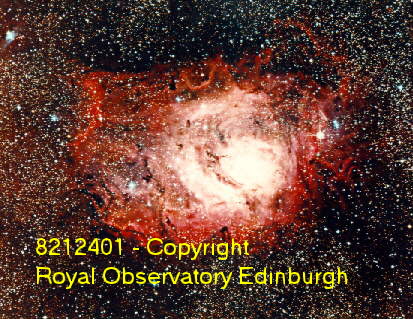

The Lagoon nebula is just visible to the unaided eye as a fuzzy patch in the constellation of Sagittarius, close to the centre of our Milky Way galaxy. The name "Lagoon" was given to this nebula by astronomers using early telescopes because of the dark strip crossing the bright nebula. The Lagoon is one of the best known of the "HII regions", so called because they consist mainly of ionised hydrogen gas. This part of the Milky Way contains many other HII regions, star clusters, dark nebulae and other objects associated with the spiral arms and central parts of our galaxy.
The Lagoon nebula (also known as NGC 6523) surrounds a cluster of hot young stars (NGC 6530). The brightest part of the nebula contains the tiny "Hourglass Nebula" which cannot be easily distinguished here from the rest of the bright gas. This nebula is associated with one of the hottest and youngest stars known, Herschel 36, which is probably less than 10,000 years old. (The Sun is about 4,500 million years old.) These hot young stars are ionising the surrounding gas cloud, from which they formed, which then re-emits the radiation in the red light of hydrogen. The nebula also shows many dark globules, compact small dust clouds which completely obscure the light from more distant stars; these clouds may well be the source of future star formation.
The Lagoon Nebula is at declination -24 degrees and therefore not easily visible from Britain although it can be seen, in very clear conditions, from much of Europe.
North is up and East to the left. This photograph covers an area of sky just over a degree across (about four full moons).
(This photograph was made from three black and white photographic plates, exposed through blue, green and red coloured filters, taken with the UK Schmidt Telescope in Australia. The colour picture is produced by sequentially printing the original photographs through the appropriate colour filter onto colour material. Colour film, as used for conventional photography, does not register the true colour in objects as faint as this. The three-colour process as used here allows the beautiful colours of the nebulosity to be revealed.)